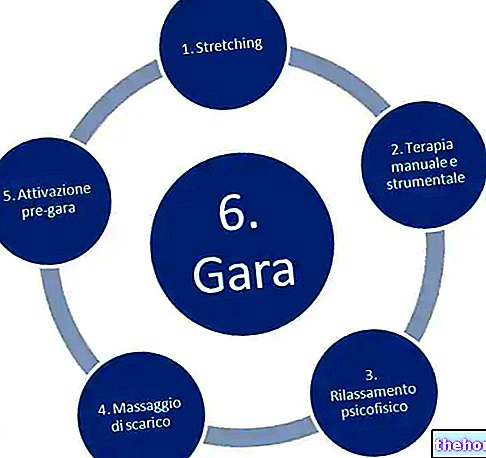In fast runs, the development of the running technique is strictly linked to the frequency and amplitude variables of the movements, and to the time of foot support; it follows that: to increase the running speed, it is essential to improve the amplitude and frequency of the steps also thanks to the parallel reduction of the foot rest times.
In the first phase of fast running, by increasing the speed, both the foot rest time and the step frequency are gradually reduced; only in a second moment, while observing a continuous reduction of the time of support of the foot, does a gradual decrease of the amplitude occur, opportunely compensated by the greater increase of the step frequency.
Ultimately, the training of fast runs essentially depends on the ability to develop both the amplitude and the frequency of the step, since they constitute the essential elements (together with the support) of the rhythmic of the race.
Obviously, for the training of fast runs in athletics, the variability and subjectivity of the athletic characteristics require a certain level of experience and technical preparation on the part of the coach, who should evaluate the technique of race and understand what the shortcomings of each specific athlete are; ultimately, the technician MUST be able to understand how to make the runner reach the right balance between: amplitude and frequency of step, and foot support time.
Calculation of the performance model in fast running of athletics (for advanced athletes)
The pace of the fast run is measured on the basis of the length of the lower limb, barefoot, starting from the midline of the greater trochanter to the ground; the value obtained is multiplied by 2.6 in males and 2.5 by the females, thus obtaining the LENGTH OF THE STEP. By dividing this value by 100 and using it as a divider over the distance of 100m, it is possible to obtain the NUMBER of STEPS in 100m of RUNNING RUN and, by adding 10%, from this value it is possible to obtain the NUMBER CORRECT STEPS TO START FROM THE 100m RACE BLOCK.
Ex.: Male athlete with 90cm of leg length; female athlete with 88cm leg length
Male
Female
Length of the stride in the running run
90 cm * 2.6 = 234 cm
88 cm * 2.5 = 220 cm
Number of steps in 100m of run 100m
m 100: (234: 100) = 42.7
m 100: (220: 100) = 45.5
Number of steps in the race
42,7 + 10% = 47
45,5 + 10% = 50
Starting from this it is therefore possible to establish a performance model of the service conceivable for the individual athlete and finalize the training for this purpose, by intervening on the parameters of amplitude and / or frequency of the step.
Presumed performance model, referring to the above example
Parameters
Male
Female
Race time
10,6
11,7
No. steps in 100m to the blocks
47
50
Average frequency of steps
4,43
4,27
Average step length
213 cm
200 cm
Running step length launched
234 cm
220 cm
ATTENTION! This is a project NOT applicable in the first 17 years of life, as the anthropometric measures and muscle efficiency are not comparable to those of an adult human being; moreover, up to 19 years of age, it should constitute a simple model indicative.
It is therefore logical that it will be the precise task of the coach to identify the muscle sectors directly involved in the expression of one or the other variable (frequency and amplitude of the step) and strengthen them and / or lengthen them based on specific athletic deficiencies:
- The ability to develop WIDTH essentially depends on the flexor muscles of the legs and the mobility of the hip on the spine.
- The ability to develop FREQUENCY depends above all on the extensor muscles and in particular on its STIFNESS (compactness).
It follows from this that it is possible to define 2 groups of exercises that selectively intervene on the flexor and extensor muscles, improving the amplitude and frequency of fast running in athletics.
Exercises for the width of the steps in the training of fast running in athletics
- Horizontal, alternating and successive multi-jumps
- Thigh flexor and leg strengthening exercises on the thighs (weighted shoes and anklets, sets of 10-20-30 reps)
- Skip with or without ankle braces, run in place with high knees (sets 60-80-100 up to 200 rips each)
- Race jumped on 60-80-100m by detecting time and number of jumps
- Wide run on 60-80-100m detecting time and number of steps
- Walker's pace with long and fast strides over distances of 60-80-100m, mainly involving the hips

Exercises for the frequency of the steps in the training of fast running in athletics
- Horizontal, alternating and successive multi-jumps
- Exercises with the rope, enhancing the rapid bounce of the feet with locked knees
- Quick and successive pushups bringing the thigh up to the horizontal with rapid rebound from the ground (25 reps)
- Fast, circular motion from standstill with one lower limb at a time (25 reps)
- Skip with and without weighted belts (overload of 15% of body weight) in series from 60-80-100 up to 200 rep.
- Sprint with tow and with weighted belts on 30 and 60m respectively
- Fast and circular run with short and round steps 60-80-100m, timing the time and counting the steps.
Bibliography:
- The Handbook of the Athletics Coach - First part: general information, races and walking - Study & Research Center - pag. 21:38.
Other articles on "Running rhythm in" fast running training "
- The technique of fast running in athletics
- Strength training for fast track and field runs
- Speed and endurance training for fast track and field runs
- Single periodization of training in fast runs - 100 and 200m
- Double periodization of training in fast runs - 100 and 200m
- Single Periodization Training Fast Runs - 400 meters
- Double Periodization Training Fast Runs - 400 meters




























